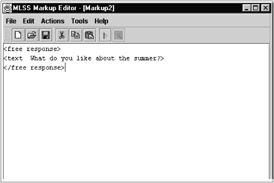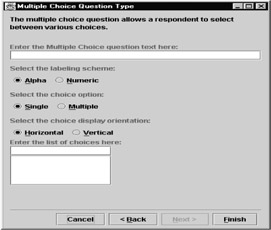MLSS Interaction Modes
|
|
Command Language Mode. Subjects are asked to build the survey markup text on a text editor, which is part of the MLSS Integrated Development Environment (IDE). The subject was provided with materials to assist them in completing the task, but it basically involved the creation of code character by character. This interaction method may provide for better performance and efficiency by experienced users, who through this mode must solve the problem with interpretive instructions and who are working with a familiar task (Norman, 1986).

Figure 1: Command Language Mode
Wizard (Menu-Form) Mode. A subject creates an online survey using a sequence of menu screens, which "walks" or "holds the person's hand" through the interaction process. This menu consists of both selection and fill-in-the-blank type items. The system correspondingly builds the markup language, line by line until the entire markup question structure is completed. The advantage of this method is it allows users to build the markups without needing to be concerned with the syntax and details of coding each line of the markup language tags and elements. From a theoretical perspective, it could be said the menu-based method provides for specific instructions for a non-familiar task, which may make it ideal for novice users. On the other hand, it may result in slower, less efficient performance for experienced users (Norman, 1986). The menu structure, built in the MLSS software, and designed specifically for this research is designed to aid the novice user in building markups using a combination of "multiple choice" and "form fill-in" input items. It is a form of "training wheels" learning system (Carroll & Carrithers, 1984) whereby someone can enter the inputs and see on the screen how the markups are being built automatically.
In particular, the issues of menu performance and the depth/breadth tradeoff were given attention when designing the menu-driven system for the MLSS software. The ideal menu structure should have four to eight items per page, and would not have too many levels. This more depth/less depth structure is found to bring about better efficiency and performance. One element of the research would be to look at how experts and novices perform using both the menu-driven system and the command interface.

Figure 2: Wizard Mode
The combination of a broad/shallow menu structure and form fill-in input allow for the quick and easy input of data and the corresponding building of markups without actual coding of the language code are the benefits of the MLSS system.
The effects of the use of a specially designed menu structure on the learning and usability of command markup languages is a focus of this research.
|
|
EAN: 2147483647
Pages: 186